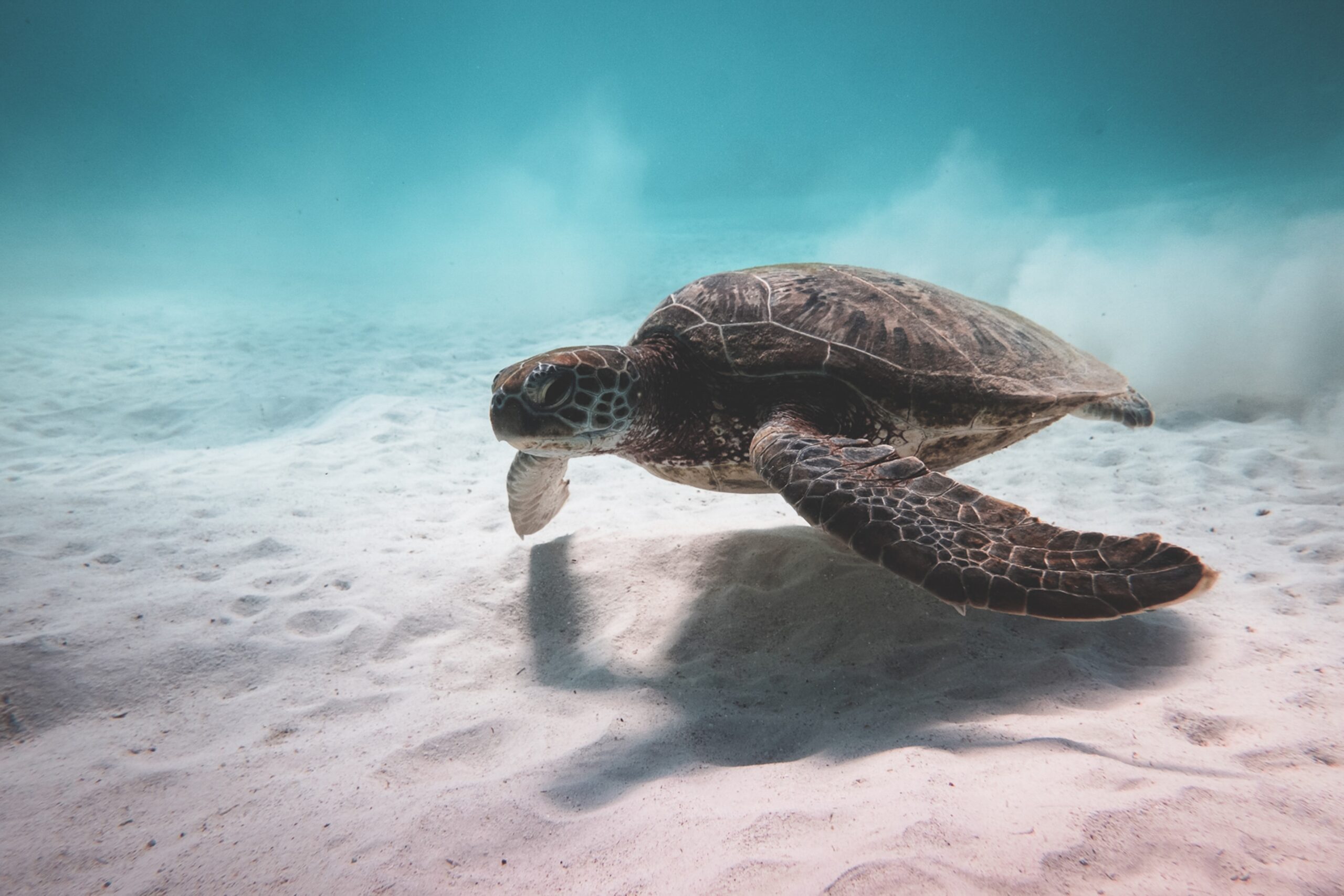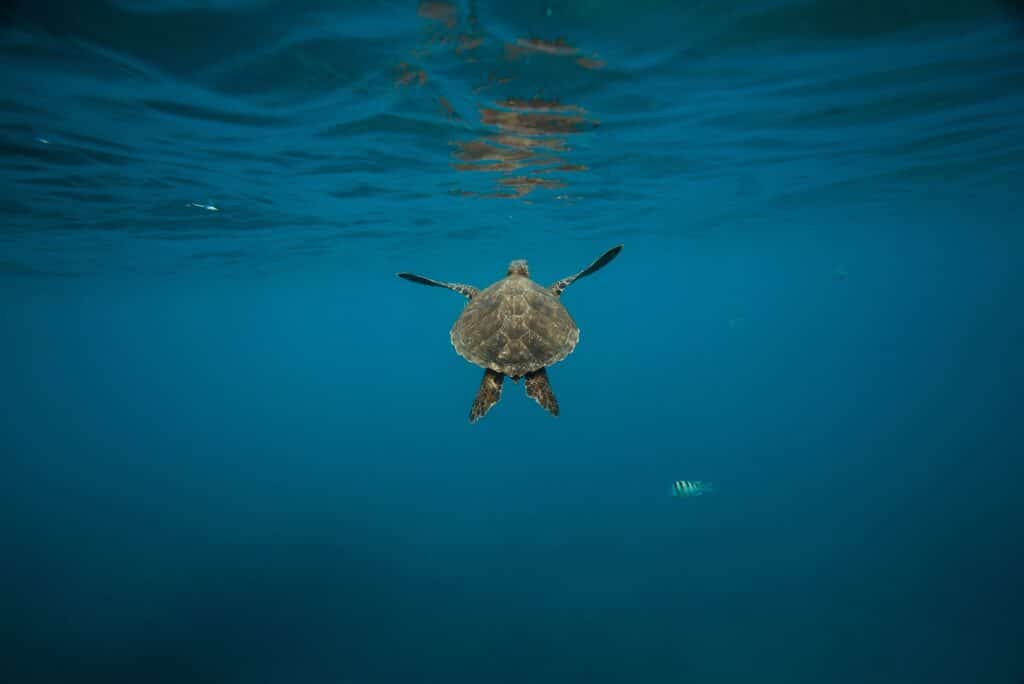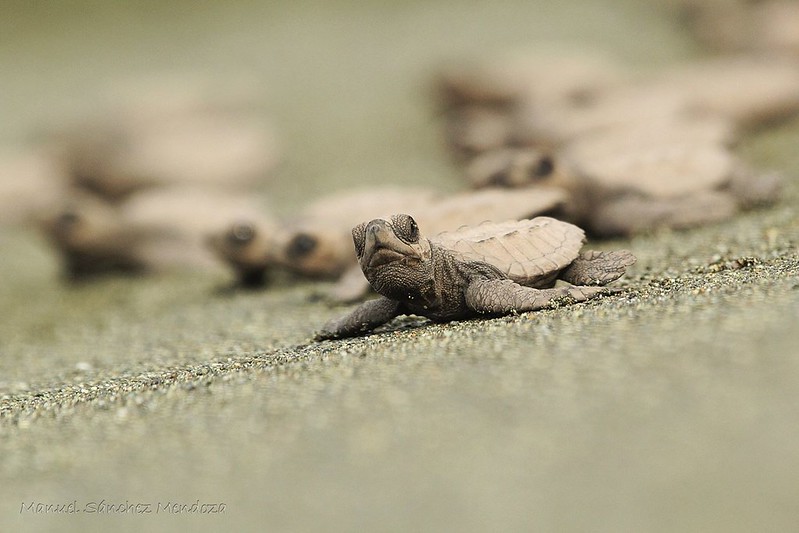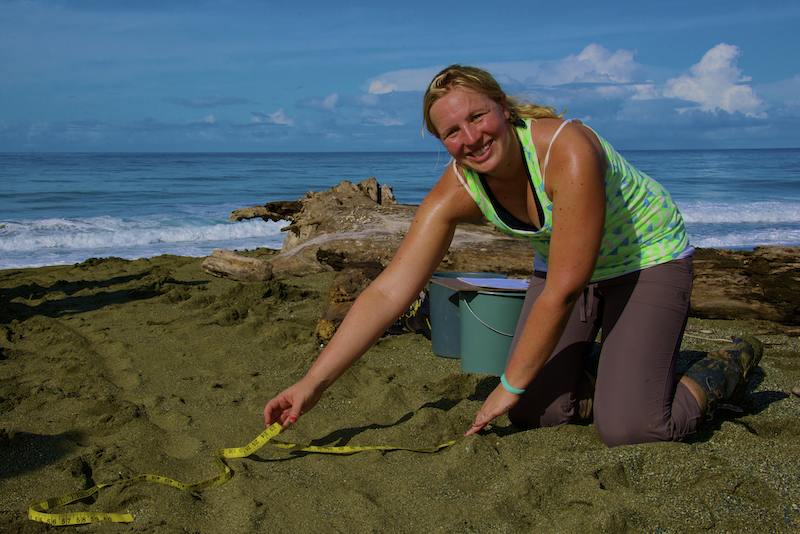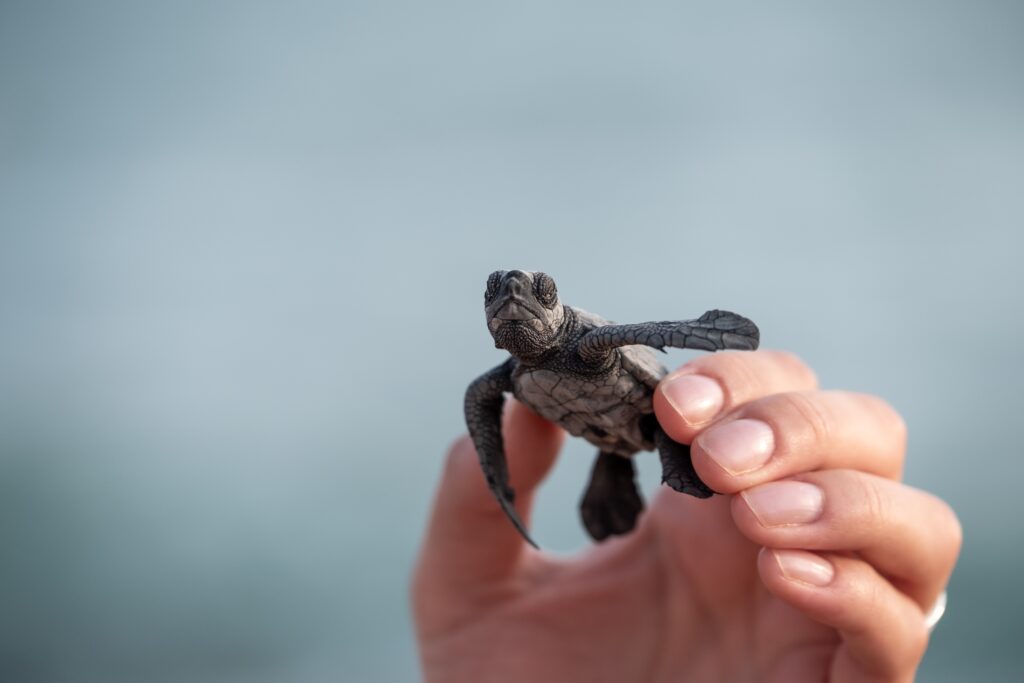Sea turtles are one of the most widely loved and appreciated species in the animal kingdom. As a source of awe and inspiration, sea turtles have proven to be one of the world’s most popular animals. I mean think about it, who doesn’t love watching these beautiful creatures glide through the ocean? Isn’t it such a treat when you get to see one pop its head above the water?
Whether you’re a sea turtle fan or just want to know more about this incredible animal, keep reading! There is a lot to cover when it comes to sea turtles:
- The different kinds of sea turtles
- Sea turtle facts
- Why sea turtles are threatened
- How YOU can help the sea turtles
- Top places to help save the sea turtles
- Top 5 places in Costa Rica where you can help save the sea turtles
Thinking about taking a trip abroad to catch a glimpse of a sea turtle for yourself? Consider Costa Rica as your next destination. This country is not only home to an abundance of sea turtles, but there are also many organizations that can help you facilitate an encounter, including Blue Osa. And while you’re at it, why not turn your trip into a real eco-adventure. At Blue Osa, not only will you be in the same environment as sea turtles but you will also get to relax and enjoy what nature has to offer. Check out some of our upcoming retreats to find out if there is a trip that is right for you!
Why Sea Turtles Are So Important
A healthy ocean needs sea turtles. They serve an important role in influencing other species around them. Sea turtles also play an important part in regulating ecosystems and keeping ocean habitats under control. As a keystone species, sea turtles can also help humans! Did you know that many coastal economies and native communities actually rely on sea turtles for jobs and income? Because turtles are so important there are a lot of organizations that work to help turtles rehabilitate.
Around the world, there are millions of people who admire sea turtles and want to know more about them. If you’re reading this article, it probably means that you do too! So let’s take a deep dive into the life of a sea turtle. We’re going to explore where you can find them and also how you can help contribute to their species!
7 Species of Sea Turtles Around the World
Turtles are everywhere! In fact, there are actually more than 350 kinds of turtles around the world. But when it comes to sea turtles, there are seven different kinds. So let’s take a look at some of the different species of sea turtle, four of which are present in Costa Rica!
1. Leatherbacks (Dermochelys coriacea):
Status: Vulnerable
Leatherback turtles are the largest of the sea turtles. They can reach lengths of over six feet and can weigh up to 2,000 pounds. They can be found nesting on tropical beaches but can migrate as far north as Canada. In terms of food, leatherbacks rely on jellyfish as their main source of nutrition.
Unfortunately, it’s difficult for them to distinguish between ocean debris and jellyfish. At times they ingest foreign particles resulting in sickness or even starvation.
The leatherback sea turtle has a unique and beautiful shell consisting of a single piece of 5 ridges.
2. Green Turtles: (Chelonia mydas)
Status: Endangered
Weighing up to 350 pounds, the green sea turtle is another hefty turtle with a carapace (back of the turtle shell) measuring up to three-feet long. The name, “green turtle” comes after the color of the turtle’s green skin, not the shell which is actually a brownish color. Unlike most other turtle species, adult green turtles are herbivores. Baby green turtles do feed on crabs, jellyfish and sponges.
Throughout the world and a subpopulation in the Mediterranean, green turtles are classified as critically endangered. Because of humans, these turtles are most likely killed for their meat and eggs. Green turtle numbers are also reduced by boat propeller accidents, bycatch, and the destruction of nesting grounds by human encroachment.
3. Loggerheads (Caretta caretta)
Status: Endangered
Loggerheads are reddish-brown in color and have very large heads (hence the name). They can grow to be three to five feet long and weigh up to 400 pounds. Loggerheads roam vast areas of the ocean so their nesting areas can be found across several countries. For example, they are the most common turtle species to nest in Florida.
Feeding mostly off of crabs, mollusks and jellyfish, Loggerheads are very similar to leatherbacks. However, much like other turtles, the loss of suitable nesting beaches and the introduction of exotic predators have taken a toll on the loggerhead population. They have also been deeply affected by fishing gear and will often get trapped in fishing trawls.
4. Hawksbill (Eretmochelys imbricate)
Status: Critically endangered
Hawksbills are named after the shape of their beak which looks like the beak of a raptor. They can grow up to lengths of three to five feet and weigh up to 180 pounds. They live in tropical waters and feed on sponges.
Hawksbills are critically endangered and this is most likely due to human impact. Their unique tortoiseshell pattern makes them a prime target for hunters.
5. Olive Ridleys (Lepidochelys olivacea)
Status: Vulnerable
The olive ridley species is found in tropical regions around the world and is named after its olive-colored shell. Weighing less than 100 pounds, the olive ridley is much smaller than most other turtle species. They like to feed on invertebrates such as crabs, jellyfish and tunicates. Although, some eat mostly algae.
When nesting, females come to shore in colonies of up to one thousand turtles and have mass nesting aggregations on the coast of Central America and East India. Sometimes, the mothers lay their eggs too close to the shore which results in the nests being wiped out. Several projects are in place to help protect olive ridleys including Osa Conservation where there is an effort to relocate vulnerable nests to a nearby hatchery.
6. Kemp’s Ridleys (Lepidochelys kempii)
Status: Critically endangered
The Kemp’s Ridley is the smallest sea turtle of the bunch, measuring up to 30 inches and weighing 80-100 pounds. They are coastal turtles and are found in temperate to subtropical waters in the western Atlantic and Gulf of Mexico. These turtles like to eat benthic organisms, such as crabs. Hunting was once the biggest reason for their endangered status, but today major threats include habitat loss, pollution and entanglement in shrimping nets.
7. Flatbacks (Natator depressus)
Status: Data deficient
As the least endangered of all the turtles, flatbacks are named for their flattened olive-gray carapace. They are only found in Australia and live in coastal waters. Flatbacks feed on squid, sea cucumbers, soft corals and mollusks.
The lack of research into the flatback population prevents us from knowing more about their abundance and distribution across Australia.
Incredible Sea Turtle Facts
There are so many amazing opportunities to observe wildlife in its natural environment here on the Osa Peninsula. You don’t even have to leave the property to see all of the amazing animals that share this beautiful piece of land with us. From sloths to monkeys, to coatis to frogs, each day you are sure to spot a new creature!
One of the most amazing and precious animal neighbors we have here is the sea turtles. If you’re lucky, walking down on the beach one night you might be able to spot one of these magnificent creatures! But for those of you who are a little further away, here are ten cool sea turtle facts that can help you get to know these wonderful animals a bit more!
10 Fun Facts About Sea Turtles
- Birthplace: Female sea turtles will return to their place of birth to lay their eggs. Sometimes, they will even nest mere inches from their own birthplace!
- Age: Only one in a thousand hatchlings make it to adulthood, but the ones who do can live up to 100 years! Getting past puberty is rough for everybody.
- Weight: Sea turtles can be massive and weigh up to two thousand pounds! Imagine finding a turtle that big while swimming in the ocean.
- History: Sea turtles are amongst the oldest creatures on earth with fossils dating back to 150 million years. This means that sea turtles were around while dinosaurs walked the planet.
- Diving Deep: Leatherbacks can dive to a depth of more than a mile in search of their prey, jellyfish.
- World Travelers: Sea turtles rack up the frequent floater points as incredibly ambitious swimmers. They can cover more than 10,000 miles each year as they explore the ocean.
- Breath: The feeding dives of green turtles usually only last five minutes or less but they can hold their breath for up to seven hours! Yogis, please don’t try this at home…
- Monogamy: Turtles are not monogamous and will mate with several partners during the course of a season. If the shell’s a-rockin’, don’t come knockin’.
- Gender: A sea turtle’s gender is determined by the temperature of the nest. A nest that is left in warmer temperatures will produce turtles that are all female while a nest in a cooler spot will produce male turtles. (If you’ve ever wanted to play god, a sea turtle hatchery is where you can experience it)
- Mythology: Indian mythology asserts that the survival of the sea turtle ensures the survival of the world. According to the myth, Earth rests on the back of three elephants. These elephants in turn stand on the shell of a giant sea turtle that swims in an infinite sea. It is believed that if the sea turtle disappears, the world will end… To save the sea turtle!
There are so many interesting facts and things to learn about turtles as these are only some of the great things about them. If you want to learn more about sea turtle hatchlings, check out this great interview!
Why Are Sea Turtles Threatened?
Sea turtles have been living on this planet since the time of the dinosaurs. That means they have been around for 110 million years! There are so many great things about sea turtles and as mentioned before, we need them in our ecosystems. However, there are many threats that sea turtles face today that are causing their populations to diminish. The truth is, the greatest threats that sea turtles face aren’t natural predators or natural factors. The greatest cause of threat to sea turtles is humans. There are many human-made threats that can cause harm to sea turtles including:
- Boat strikes
- Garbage consumption
- Bycatch (accidental catch in fishing nets)
- Beach destruction and destruction of habitat
- Poaching for meat and eggs
And these are only some of the ways that humans are impacting sea turtles. According to the International Union for Conservation of Nature, out of the seven species of sea turtles around the world, six are classified as threatened or endangered. Experts even suggest that only one in one thousand hatchlings will survive adulthood.
So now you might be thinking, how can I help? Well, let us tell you!
How YOU Can Help Sea Turtles
No matter where you are in the world, you can help save the turtles! Below are some great tips you can follow to help improve turtle habitats and reduce the many issues that sea turtles face.
- Become Seafood Conscious: You can become a conscious and responsible seafood consumer by making sure that your seafood is sourced locally. Always ask where and how it was caught. It is important to choose seafood that was caught in a way that does not harm or hurt sea turtles
- Carry a Reusable Water Bottle: Avoid buying plastic water bottles by purchasing a reusable water bottle. Take it with you when you travel and leave the house. This will reduce the amount of plastic you throw away and make you a more conscious consumer
- Carry a Reusable Shopping Bag: Much like having a reusable water bottle, having reusable shopping bags will allow you to reduce your plastic waste, therefore help the environment. In many cases, plastic bags will end up in the ocean and this can appear like food for sea turtles.
- Clean Up After Yourself: If you have been relaxing at the beach or visiting an area where sea turtles may nest, make sure to clean up after yourself. Objects like chairs, umbrellas, and beach equipment can deter sea turtles from nesting sites. Clean up after yourself so that sea turtles don’t turn away.
Take the Save The Sea Turtle Quiz!
Top 10 Places to Help the Sea Turtles Around the World
1. Kenya – Watamu Sea Turtle Volunteer Project
The aim of this project is to protect the sea turtle population in the area through research and monitoring of nesting turtles. The project also works to rehabilitate sick and injured turtles. Not only will you get to help conserve the local Kenya sea turtle population but you will also get to experience the local culture and stunning beaches of the Watamu coastline. Community projects are also a highlight for many volunteers.
Click here to find out more about Watamu Sea Turtle Volunteer
2. Sri Lanka – Sea Turtle Rescue and Rehabilitation
If you’re looking to help save the sea turtles and are into walking the paths of Buddhist pilgrims and swim the tropical waters of the Indian Ocean, this may be the perfect adventure for you. As a volunteer, you’ll work in Ambalangoda, a beautiful town on the ocean where one of the main industries is fishing. Sadly, sea turtles often become caught in nets from fishermen and lose their limbs. Once disabled, these turtles cannot live in the wild, so many Sri Lankans rescue them. Later they can move them to the project site where they can be cared for and rehabilitated.
Click here to find out more about sea turtle rescue and rehabilitation in Sri Lanka
3. Mexico – Cozumel Marine Turtle Salvation Program
Cozumel plays host to thousands of sea turtles coming ashore to nest each year. During the nights of mid-May through mid-November, on the Eastern shore of the island, two species of sea turtles come ashore to lay their eggs. The bays and reefs of the Cozumel area are foraging areas where sea turtles (such as Hawksbills and Giant Leatherbacks) have been seen swimming offshore.
Click here to find out more about Cozumel Marine Turtle Salvation Program
4. Barbados – The Barbados Sea Turtle Project
The Barbados Sea Turtle Project is based at the University of the West Indies (Cave Hill Campus). For over 25 years, they have been involved in the conservation of the endangered marine turtle species that forage around and nest in Barbados. Their profile is about research, education, and public outreach as well as monitoring of nesting females, juveniles and hatchlings.
They accept volunteers between May and November each year, usually for periods of 2-4 months.
Click here to find out more about the Barbados Sea Turtle Project
5. Borneo – Borneo Marine and Sea Turtle Conservation
This project focuses on protecting and replanting coral reefs. It also plays a big part in sea turtle conservation. Located on the Pom Pom Islands, many green and hawksbill sea turtles call this area home. Easy to spot, nests are considered a delicacy for sea gypsies and are often a big target to be hunted. At the Borneo Marine and Sea Turtle Conservation Project, you will help to patrol the island at night and tag turtles for data collection.
Click here to find out more about Borneo Marine and Sea Turtle Conservation
6. Indonesia – Bali Sea Turtle Rescue
The goal of this project is to rescue and rehabilitate sea turtles that have been gathered by local fishermen. As an integral member of the team, you will help to care for injured turtles and return them to their natural environments. During this time, you will also get to help the Balinese community. Here you can educate children and teach the local people about the importance of turtle conservation.
Click here to find out more about Bali Sea Turtle Rescue
7. United States – Hawai’i Wildlife Fund
Founded in 1996, the Hawai’i Wildlife Fund leads research, monitoring, and conservation efforts to help protect Hawai’i’s fragile marine ecosystem. This includes the hawksbill sea turtle as well as the green sea turtle. The organization engages and inspires communities and volunteers in education, outreach, marine debris removal and conservation. There are many ways you can help with the organization from volunteering, to donating or even adopting an animal!
Click here to find out more about Hawai’i Wildlife Fund
8. Ecuador – Turtle and Marine Environmental Conservation
This project aims to support turtle and marine environmental conservation and education in Ecuador. During your time spent as a volunteer, you will assist with research, conservation and education with project sites located on the Pacific Coast. With a specific focus on endangered hawksbill turtles, green turtles and olive ridley species, the work also examines the habitats of sharks and other marine life.
Click here to find out more about Turtle and Marine Environmental Conservation
9. Australia – Great Barrier Reef Turtle
Located in Cairns, this rehabilitation center treats injured and sick marine turtles brought in from the Great Barrier Reef and Cape York Peninsula. Thanks to volunteers and donations from local businesses, the center is able to be kept running. It has helped more than 170 sick and injured animals over the past 10 years. Currently, there are three species of turtles in care including green turtles, hawksbill turtles and olive ridleys.
Click here to find out more about Great Barrier Reef Turtle Rehabilitation
10. Canada – Canadian Sea Turtle Network
The Canadian Sea Turtle Network is a collaborative sea turtle conservation initiative. It involves scientists, commercial fishermen, tour boat operators, and coastal community members. Home to seasonal populations of endangered leatherback loggerhead sea turtles, the waters off Atlantic Canada can experience an abundance of turtles. In the warmer weather, these turtles visit Canada to feed off of jellyfish and eat before migrating back south.
Click here to find out more about Canadian Sea Turtle Network
There are so many places around the world to help out sea turtles and get your hands wet to help with conservation efforts. So if you really want to travel with a cause, consider one of the options above. If you are in Costa Rica there are also more places to see the sea turtles for yourself.
Top 5 Places to Help the Sea Turtles in Costa Rica
Just in case you want to squeeze in some sea turtle time on your way to or from Blue Osa Yoga Retreat + Spa, below are some great sea turtle organizations in Costa Rica. This is a wonderful activity for all ages to experience the amazing wildlife of Costa Rica while also giving back to the community. It also helps to preserve the wonders of the country for future generations.
1. Osa Conservation
If you’re a nature lover and passionate about conservation, this is the place for you. We love visiting the Piro Research Station, about a 25-minute drive from Blue Osa, to help out in the newly built hatchery. Witnessing the baby olive ridley sea turtles safely walk back to the ocean never gets old.
Find out how you can volunteer alongside hard-working, ambitious conservationists on the Osa Peninsula at Osa Conservation.
2. Caño Palma Biological Station
At Caño, you can expect reasonably priced sea turtle volunteer packages that include training, rustic housing, three meals a day, wi-fi, use of Kayaks and Jungle Trails.
Caño Palma Biological Station is situated approximately 8 kilometers north of the village of Tortuguero on Costa Rica’s northeastern coast.
3. Corcovado Foundation
Located in the community of El Progreso, Drake Bay, Osa Peninsula, The Corcovado Foundation was created by concerned neighbors of Corcovado National Park. Their goal is to lead the fight to stop illegal hunting and loss in Costa Rica.
Take part in their various conservation activities, including night patrols, relocation of nests to the hatchery and tagging of sea turtles. They also talk about construction activities, nest exhumations, the liberation of hatchlings, and taking part in environmental education and ecotourism activities. Placements are valuable from July to December.
4. Reserva Playa Tortuga
Playa Tortuga beach is an olive ridley nesting beach, although it is possible that other species occasionally arrive. The nesting period extends from July to December, with peak nesting in September and October. During this period, if it is possible to observe an individual every other night.
As a Playa Tortuga volunteer, you’ll have the chance to learn about the biology of sea turtles, especially the olive ridley. Find out how you can get involved at Reserva Playa Tortuga in Costa Rica.
5. Ecology Project International
This organization helps facilitate many conservation efforts around the world, including sea turtle conservation in Costa Rica. Find out how you can work in one of the world’s most important nesting sites for Leatherback Sea Turtles here.
These are just five of the most reputed turtle conservation organizations in Costa Rica, where it’s possible for tourists and volunteers to save these amazing species.
Blue Osa Yoga Retreat + Spa is committed to saving as many sea turtles as possible. We believe if everyone does their part, it will be possible to recede the risk of extinction to these amazing creatures.
Save the Sea Turtles on Your Next Yoga Retreat
Calling all yoga teachers! Have you planned your next yoga retreat? If you are an avid yogi and a big sea turtle lover why not combine these two passions and save the sea turtles on your next yoga retreat?
Every year, the travel and tourism industry generates trillions of dollars and supports millions of jobs worldwide. And although the pandemic caused a lull in business, the fascination with travel continues to be a popular subject.
Throughout social media, hashtags like #travel, #bucketlist and #wanderlust continue to infiltrate newsfeeds and urge people to pull out their passports and jet sets to the other side of the globe. But today’s travelers seek something more than just the average vacation. The days of people looking for a beach drinking destination are over and adventure-type vacations are in. From skiing in the Swiss Alps to climbing Mount Everest, scuba diving for underwater treasures in the Galapagos to a search for ship treks in Micronesia’s Truk Island – adventure travel is the new way to go. And guess what? So is yoga travel.
Each year, more and more adventurers are spending their vacation dollars on yoga travel, finding ways to experience relaxation and peace for extended periods of time. Back in 2008, Yoga Journal published an article that states that practitioners spend $630 million per year – 11.25% of total yoga-related spending on yoga-based retreats and vacations.
Now, many years later, we can only guess what the industry is worth based on the number of yoga travel-related websites and industries that have popped up. But it would be too simple to say that yogis only want adventure. We all know that they are looking for much more.
Years ago, yoga retreats used to be: sleep, eat, pray, om and asana. Now, this structure looks a little different. Yogis want to do something more with their vacation instead of just standing on their heads all day long. And as a teacher, you need to offer your students more.
Service to the community (seva) retreats is becoming increasingly popular. For example, practice yoga in the mornings and build a home or school in the afternoon. Yogis will leave this experience feeling not only empowered from a daily yoga practice, but their lives will become much more enriched from the experience of giving selflessly.
At Blue Osa, we can help you contribute and make a difference in the world around you. What we have noticed is that as more yogis come to Blue Osa, they want to help out and do more. And making events or services part of your retreat is a win/win for everyone! Here are some reasons why making service part of your retreat is a great idea:
- Your student has a better experience with an expansive worldview
- You are able to incentivize your yoga retreat value
- You are given a lot more marketing opportunities
- Everyone involved feels like they have truly made a difference
- The people on the receiving end are deeply grateful
Why Blue Osa is the Best Choice for a Yoga Retreat
Located in a remote corner of Costa Rica, Blue Osa is the perfect place to get the most out of your wilderness vacation. Did you know that the Osa Peninsula harbors 2.5 percent of the biodiversity of the entire planet in less than a thousand percent of its total surface area? Blue Osa is so blessed to host yogis from around the world who want to join our efforts in supporting Osa Conservation in saving the rainforest and the sea turtles. Check out this video to learn more about the wildlife around Blue Osa.
After 130 million years of existence, the future of the magnificent creatures that live around Blue Osa depends on us. Here are some facts about the wildlife around Blue Osa:
- Monkeys are everywhere on the Osa Peninsula. We actually have four species surrounding this area!
- Every night the sound of frogs is heard throughout the Osa
- Sometimes, you can see otters in a river close by called Tamales River
- Hummingbirds fill the gardens. The more flowers, the more likely you will see these magical creatures
- The Osa is home to over 319 species of birds
- Just like sea turtles, there are also many other species of turtles that live in rivers and creek beds
We covered a lot in this article, but there is so much to learn about sea turtles, their life cycles and why the Osa Peninsula is the best place to host your yoga retreat to see these magnificent creatures. There is just so much to love about sea turtles so why not turn your yoga retreat into a yoga adventure with some extra wildlife! So take a look at some of our upcoming retreats as well as our sea turtle release program.


